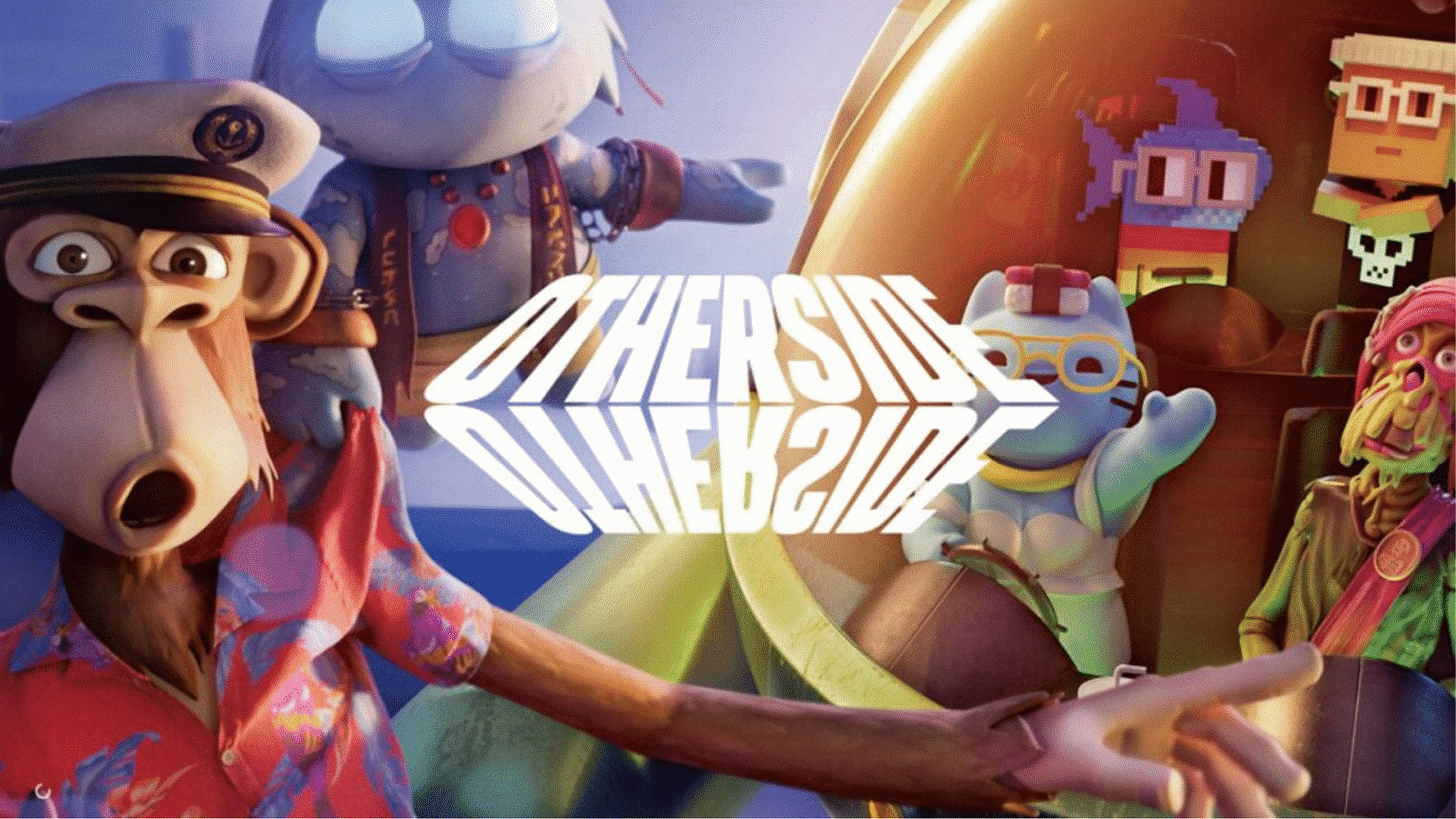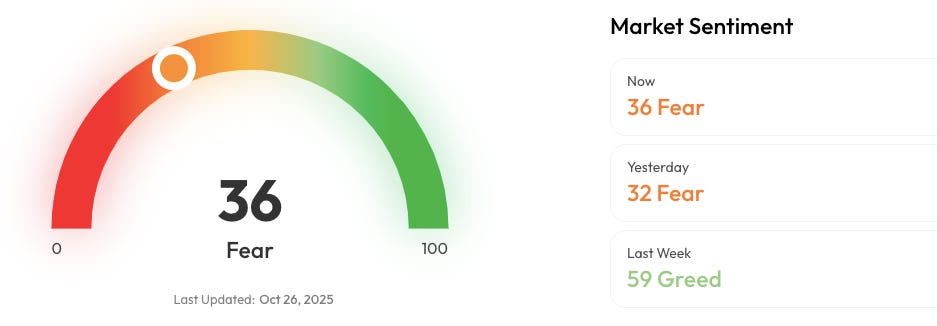Weekly Journal: Yuga Labs Long Hyped Otherside Metaverse Launching 12th Nov
[6 min read] Your weekend guide to getting ahead on the digital frontier. The Otherside metaverse is scheduled to launch Nov 12, 2025.
Welcome to this week’s Weekly Journal 📔, your guide to the latest news & innovation in emerging technology, digital assets, and our exciting path to the Metaverse. This is week 150 of the 520 weeks of newsletters I have committed to, a decade of documenting our physical and digital lives converge. New subscribers are encouraged to check out the history & purpose of this newsletter as well as the archive.
- Ryan
🌐 Digital Assets Market Update
To me, the Metaverse is the convergence of physical & virtual lives. As we work, play and socialise in virtual worlds, we need virtual currencies & assets. These have now reached mainstream finance as a defined asset class:
🔥🗺️Heat map shows the 7 day change in price (red down, green up) and block size is market cap.
🎭 Crypto Fear and Greed Index is an insight into the underlying psychological forces that drive the market’s volatility. Sentiment reveals itself across various channels—from social media activity to Google search trends—and when analysed alongside market data, these signals provide meaningful insight into the prevailing investment climate. The Fear & Greed Index aggregates these inputs, assigning weighted value to each, and distils them into a single, unified score.
🗞️ Metaverse news from this week:
🐒 Bored Ape Yacht Club Swings Back — With “Otherside,” Its Own Metaverse
The Bored Ape Yacht Club (BAYC), once the emblem of NFT excess, is staging a comeback—not as a JPEG collection, but as a fully fledged metaverse. Creator Yuga Labs has confirmed that its long-teased virtual world, Otherside, will officially launch on November 12, signalling a strategic pivot from hype-driven collectibles to a persistent social-gaming platform.
Backed by $450 million in venture funding, Otherside aims to fuse the accessibility of Roblox or Fortnite with the digital-ownership ethos of Web3. Players can join via browser or crypto wallet, roam user-generated worlds, and use NFT avatars and land as tradable assets. The platform also introduces “Voyager” avatars—custom 3D characters, including collaborations with Daniel Arsham and Amazon’s Boximus—positioned as blockchain-based “skins” that can be resold. Early testers describe the experience as a sprawling 3D social hub: The Swamp, a moody virtual bayou anchored by the BAYC clubhouse, and The Nexus, a shared hub world. Community-made games like Bathroom Blitz and Otherside Outbreak are already being trialled.
Yuga’s Chief Product Officer, Michael Figge, calls Otherside “one of the most ambitious projects ever attempted in the space,” hoping its open-creator model and low entry barrier will attract builders disillusioned with Web2 ecosystems like Roblox and Minecraft. From a metaverse-economy perspective, Otherside represents a critical test: can a crypto-native company rebuild trust and engagement after the NFT crash by delivering genuine play, social interaction, and interoperability?
If it succeeds, it could mark the first major crossover between blockchain culture and mainstream gaming—transforming BAYC from a status symbol into an early experiment in persistent, asset-driven world-building.
If it fails, it may confirm what critics long suspected: that ownership alone isn’t enough to make the metaverse fun.
What Otherside Means for Web3
1. From speculation to participation
The NFT era was about owning pictures. The metaverse era is about owning presence. Otherside marks the pivot from digital collectibles to utility-based ownership, where assets function inside a living world rather than as static symbols of wealth.
2. Creator economy reset
Yuga Labs’ promise of user-made worlds and resellable avatars challenges Roblox’s and Fortnite’s closed ecosystems. If creators can truly monetise assets across platforms, Web3 gaming may finally find its killer use case: interoperable creativity.
3. Interoperability test case
Otherside’s success will hinge on whether it can make NFTs genuinely portable. If BAYC avatars can cross between virtual spaces without friction, it will set a new interoperability benchmark for metaverse platforms struggling to move beyond isolated ecosystems.
4. Institutional re-entry signal
Big-brand partnerships—such as Amazon’s “Boximus” avatars—suggest that major players are cautiously re-engaging with the metaverse after the crypto winter. Expect renewed VC and corporate investment if user metrics trend upward post-launch.
5. Reputation rehab for NFTs
BAYC’s revival under a social-gaming framework could rehabilitate the image of NFTs as more than speculation. But if Otherside fails to attract active daily users, it may confirm that Web3 worlds still lack compelling gameplay and purpose.
🌌 Samsung & Google Take on Apple: The Galaxy XR Launches a New Front in the Metaverse Wars
Samsung has officially entered the mixed reality arena with the launch of the Galaxy XR, a headset co-developed with Google and Qualcomm that undercuts Apple’s Vision Pro by $1,700. Priced at $1,800, the Galaxy XR is the first device built on Android XR, a new platform infused with Google’s Gemini AI assistant and designed for a future where spatial computing meets everyday life.
Powered by the Snapdragon XR2+ Gen 2, the headset delivers 4K micro-OLED displays, 90 Hz refresh, hand- and eye-tracking, iris recognition, and spatialized video that automatically turns flat content into 3D. While it feels lighter and less premium than Apple’s device, it offers a broader ecosystem—running apps from the Google Play Store, supporting PCVR for gaming, and integrating with YouTube, Play Pass, and Gemini for entertainment and productivity.
Aimed squarely at both consumers and enterprise users, the Galaxy XR ships with a training-ready suite for retail design, shipbuilding, and surgical education via ShapesXR and other apps. Early adopters get an Explorer Pack of bundled content: Google AI Pro, YouTube Premium, NBA League Pass, and more.
From a metaverse perspective, this launch is pivotal. After years of fragmented XR experiments, Samsung and Google are re-entering spatial computing together—building a cross-device Android XR ecosystem that will soon extend to smart glasses co-developed with Warby Parker, Xreal, and Gentle Monster.
If Apple’s Vision Pro positioned mixed reality as luxury hardware, Samsung’s Galaxy XR reframes it as the accessible metaverse gateway—AI-powered, platform-agnostic, and priced for mass experimentation.
📖 Read of the week: What’s Next for the Internet? Competing Visions for the Metaverse
🗞 By Nora von Ingersleben-Seip | University of Amsterdam | Published in Politics and Governance (October 2025)
The metaverse isn’t just a technological frontier — it’s rapidly becoming a geopolitical one. New research from the University of Amsterdam reveals that the United States, China, and the European Union are pursuing radically different blueprints for the next phase of the internet — each reflecting its own political and economic philosophy.
Key insights:
🌎 America – The Market-Driven Metaverse
In the US, Big Tech leads the charge. Meta, Apple, Google, Amazon, and Microsoft dominate every layer of the emerging ecosystem — from VR headsets to digital identity. With limited federal oversight, the American metaverse is evolving as a commercially driven, closed environment, optimised for profit and data capture rather than openness.
🇨🇳 China – The State-Led Industrial Metaverse
China’s government has made the metaverse a national priority, integrating XR and virtual platforms into manufacturing, education, and health. Backed by a Three-Year Action Plan (2023–2025), Chinese tech giants like Huawei, Tencent, and ByteDance are building a state-supervised industrial metaverse — one focused on productivity, surveillance, and national resilience rather than entertainment or social connection.
🇪🇺 Europe – The Rights-Driven Vision
Europe’s “Web 4.0 and Virtual Worlds Strategy” imagines an open, interoperable metaverse founded on privacy, transparency, and inclusion. Projects like Destination Earth and CitiVerse show how virtual twins can advance sustainability and urban planning. Yet Europe’s ambition is constrained by its dependence on US infrastructure and AI providers, limiting its ability to realise an independent digital ecosystem.
🧭 A Fork in the Digital Road
Political scientist Nora von Ingersleben-Seip concludes that the metaverse is not just a tech product but a political project. The choices nations make now will determine whether the future internet becomes an open digital commons or a fragmented system of walled gardens and state silos.
“The metaverse is not just a technological development — it’s a political and economic project,” she writes. “The choices made today will determine whether it becomes an open digital commons or a fragmented system controlled by a few powerful players.”
Why it matters:
This study reframes the metaverse as the next phase of global digital power competition — where regulation, values, and infrastructure rival technology itself. For founders, policymakers, and investors, understanding these three metaverse models — market, state, and rights-driven — is essential to navigating what comes after Web 3.
🔗 Read the full article via the University of Amsterdam
🎥 Watch of the week:
An interview with the leaders steering Yuga Labs, ApeCoin, and the Bored Ape Yacht Club. This discussion offers an exclusive look into what’s next for Otherside, and their ambitious goal to compete with platforms like Roblox in the metaverse.
AI Spotlight 🎨🤖🎵✍🏼: Deloitte’s $440,000 AI Blunder – and the Lesson It Teaches Us All
In the Metaverse, AI will be critical for creating intelligent virtual environments and avatars that can understand and respond to users with human-like cognition and natural interactions.
In what’s become one of the most high-profile examples of AI overreach in the corporate world, Deloitte Australia has agreed to refund part of a $440,000 consultancy fee after an official report it delivered to the Australian government was found to contain AI-generated errors — including fabricated citations, false references, and even a misattributed court quote.
The report, produced for the Department of Employment and Workplace Relations, was meant to evaluate the “Future Made in Australia” framework. Instead, it became a case study in how AI hallucinations can slip past even elite firms. Deloitte later admitted to using Azure OpenAI GPT-4o in the drafting phase, claiming the core findings were sound but acknowledging that “AI-assisted drafting” went too far without adequate human verification.
The Australian government has since reissued a corrected version and is moving toward stricter AI-usage clauses in all future consultancy contracts — a precedent that could reshape professional standards across industries.
The scandal highlights a growing risk: in the race to increase efficiency, even global firms can forget that generative AI is a probabilistic tool, not a truth engine. Without rigorous human oversight, “plausible nonsense” can easily masquerade as research.
But there’s a silver lining. The Deloitte incident has sparked a global conversation about AI accountability, from law firms and universities to audit boards. Governments are now considering frameworks for AI transparency, traceability, and ethical use, while consultants are investing heavily in AI literacy and verification systems.
Viewed through an optimistic lens, this could mark a turning point — a move from blind adoption to disciplined integration. If 2024 was the year of AI experimentation, 2025 is shaping up as the year of AI responsibility.
In that sense, Deloitte’s $440,000 mistake may prove a bargain — if it helps the world learn how to build smarter, safer, and more transparent AI-powered work.
That’s all for this week! If you have any organisations in mind that could benefit from keynotes about emerging technology, be sure to reach out. Public speaking is one of many services I offer.



